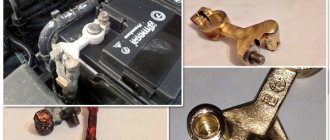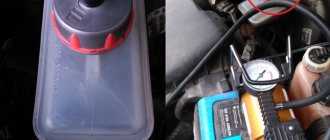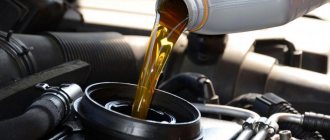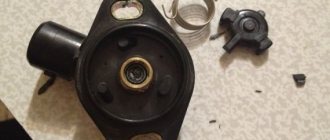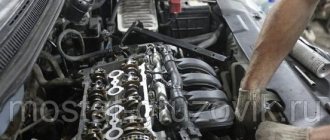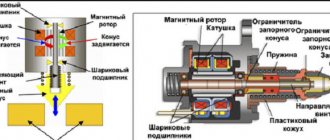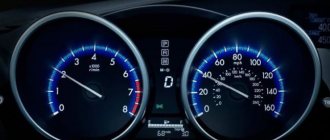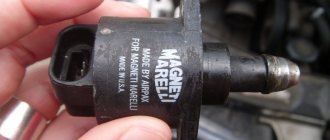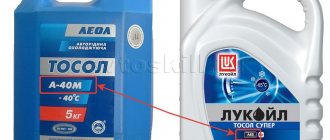- home
- car battery
- …
This problem can manifest itself both in winter (cold) and summer (warm) periods of time, and it practically does not depend in any way on winter starts. What happens when starting or when the engine is already running, one of the battery terminals begins to heat up wildly, if you drop water on it, it will begin to steam. Why does this happen and how to deal with it, let's figure it out...
At the very beginning, I want to say that this malfunction can occur on different cars (the make and model does not matter), and often this can be the reason for the battery failure, and in a very short period of time.
Why does the battery fail?
Just a couple of lines about why the battery may fail:
- Warming up the terminal, and then heating the current output and after the entire battery (including plate packs), provokes the evaporation of distilled water from the electrolyte. As the capacity drops, the plates may crumble and in general, the battery will not last long in this mode.
- If the current lead heats up, it can melt the plastic of the housing that is located next to it. Microcracks appear, through which water from the electrolyte begins to evaporate, and sulfuric acid often gets onto the terminal. Strong “oxides” form on it, which further interfere with the operation of the battery, undercharging and poor starting are possible
- YES, and the most common reason is that the case can melt from high temperatures. This is rare, but it happens; you can no longer use such a power source.
BUT this is not the only danger; a fire is not far away.
Reasons for overheating of the positive and negative terminals in the battery
When the engine starts, current flows from the battery to the starter and spark plugs, and from the generator to the battery. In the cold season, the current can be 600 A. If a wire with a small cross-section is used in the car, it can heat up, and along with it the temperature of the terminals will increase.
Main reasons for heating
- Poor contact between the terminal and the battery tip (i.e., the fit is not tight and strong enough). This occurs due to minor defects made during production, as well as due to natural wear and tear of materials, loosening of tightening nuts and bolts during long-term use.
- Oxidation processes on the inside of contacts. To eliminate this problem, you need to clean the battery terminals and tips in a timely manner.
- Increasing the resistance of materials. During operation, the wire is refracted, as a result of which its conductivity properties decrease, the current strength increases, and the metal heats up. There is only one way out - replace the wire.
- Poor contact of the negative terminal with the machine body. Experienced craftsmen and car owners advise paying attention to the fact that heating often initially occurs not in the terminals, but in the wires.
Oxidation is one of the most common causes of heating. This occurs due to the fact that the battery clamps and tips themselves are made of different metals. According to the laws of chemistry, over time they begin to oxidize at the point of contact due to the difference in potential.
The simplest reason is poor tightening of the nut on the fastening bolt. If there is some space between two contacts, then thermal energy is generated between them. Water, dust and other foreign substances can get into the clamping point, which will enhance oxidation processes.
Accidental contact of electrolyte on the contacts can also cause heating. This is a rather dangerous reason, but it is very easy to establish. Oxidation here occurs due to a chemical reaction when the metal interacts with an acid.
Why does the terminal get hot?
Quite large currents flow from the battery to the starter, and then from the generator back to the battery. Just think - starting currents, in winter, can reach up to 600A. If you install a thin wire, it will simply not be able to cope with such a load and will melt before your eyes. This is why the wires are so thick and solid, all because they are designed to carry high loads.
Let's watch a short video.
There are not many reasons and they are all banal:
- The problem is in the terminal itself . There is poor contact between the wire and the fastener, sometimes it comes straight from the factory, a manufacturing defect (for example, the hole in the terminal is 10 mm, and the wire is 8 mm).
- It happens over time that water can get into this place or oxides can form. The bottom line is that wires and fasteners are often made of different metals, the potential difference sooner or later leads to oxidation of the contact point and the current conductivity drops significantly.
- Oxides between the terminal and the current terminal. This also happens, but rarely, if the contact is bad, then the current must pass through a very narrow point of contact. Warming up can come from here.
- The wire . Sometimes the wire itself suffers, say, from an accidental break in the middle that is not visible to the eye. That is, several threads were broken, and the load that he could bear decreased.
- Poor contact with body . Often it is the negative cable and after the terminal that get hot. This is because it is bolted to the car body, and then both the starter and the generator are “powered” from the body. On modern foreign cars, the negative cable is quite short (on some cars it is attached to the engine block). So, the cable will heat up, but you will mistakenly think that it is the terminal (although with such a malfunction, the braiding of the wire itself will most likely begin to recover).
The positive terminal can only heat up from poor contact or, again, from oxides that have formed between the mount and the current terminal.
Types and materials
The materials for the terminals, as well as the design options, may vary. Basic materials for making terminals:
- Copper;
- Brass;
- Lead;
- Aluminum alloys;
- Steel.
Lead, as you know, is a soft material, has a lower melting point and worse conductivity compared to the same copper. What's the matter? The point is safety. If a short circuit occurs, fusible lead will turn into a liquid state faster than other materials. In addition, lead is resistant to battery acid, which can oxidize other terminals.
Important! The most preferred material is lead.
The most common is the European terminal standard, but there are also Asian, American, and many other forms that are marked but do not have a name. All varieties are marked with letters of the Latin alphabet. Let's look at them in more detail.
Most often, cone contacts are used for car batteries:
- Terminal type cone “A”. Plus diameter - 19.5 mm; negative with a diameter of 17.9 mm.
- “B” cone type batteries. The current contact with a minus sign has a diameter of 11.1 mm, and with a plus sign ─ 12.7 mm. Also called Asian standard.
Not so popular, but also used:
- The European standard is represented by the E shape of the screw
- The American standard comes in two versions. 1st option - type F , or screw.
- The second option for the American terminal is G , or bolted.
- There is also a Russian version. Variety T for bolt.
To be fair, it should be noted that there are a lot of types of terminals for special equipment and motorcycles. The approach and designs are individual.
I give a load - it overheats
This may often be the case. You start the car, everything seems to be fine, but after you turn on the load, say heated seats, mirrors, windshield, etc., the terminal starts to heat up! Why?
And here everything is simple and the reasons that I described above work. The thing is that the generator alone may not be able to cope with such a load (especially when the headlights, radio, and instrument lighting are working); its power is limited . Therefore, part of the energy is taken from the battery, and if your contact is bad, or there are oxides, this place will heat up.
Possible reason #4. The starter "takes over"
When they say “the starter is taking over,” it means that it is drawing more current than usual. Accordingly, the strength of the current flowing through the battery terminals increases. And as the same formula shows, as the current increases, the amount of heat generated also increases. If, at the same time, there are also bad contacts, the engine does not start with a “half-poke” (t increases), then our Q increases in all three directions.
A starter is a rather complex device, and it can “take over” for many reasons. All of them are divided into two large categories - mechanical and electrical. Mechanical causes include all failures that cause resistance to rotation of the starter rotor. Wear of bushings, contamination, jamming, problems with the motor (it is difficult for the starter to turn it) - all this creates mechanical resistance. Because of this, the starter consumes more current to operate.
The second category of reasons is electrical. This includes all breakdowns that cause large current to flow through the starter. Possible wear of the brushes, clogging of the commutator, short circuits in the rotor windings, short circuits to the housing, and so on.
What to do?
Everything is banal and simple, there are only a few points:
- All oxides must be cleaned. If they repeatedly appear on the surface of the battery, say on one side or the other, you need to look at it for leaks.
- Check the wire for breakdowns and breaks - if there are any, then it is better to replace the wire.
- You need to look at the point of contact between the cable and the terminal. Often this is where the issue lies. If it is negative, you can easily remove it and check it at home. Sometimes it’s easier to cut the cable from the terminal, buy a new one (now they sell improved copper or brass ones for audio equipment, by the way, they have a good fastening, with bolts) and then install it on your car
As a rule, all problems go away immediately. If you don’t do anything, then at a minimum your battery will fail (you won’t start your car), at a maximum and it’s not far from a fire; the wire braid may melt and short out. SO IT IS SURE TO ELIMINATE!
I’ll end with this, I think it was useful, read our AUTOBLOG, subscribe to the YOUTUBE channel.
Similar news
- Gel or acid battery. Which is better? Only facts + B...
- Battery bank. What it is? How many are there? What is the voltage
- Batteries “Europe” and “Asia” - what are they? How to determine and what they...
Add a comment Cancel reply
Possible reason #2. Insufficient cross-section of power cables
The power wires in a car are considered to be those that go, first of all, to the starter. If they were replaced the day before, then it is likely that in order to save money, cables that were not thick enough were purchased. This means that their resistance is higher than necessary. Accordingly, according to the same formula, heating of the terminal can be observed. Moreover, in this case, the terminal itself may not be a source of heat. Initially, thin power cables overheat, and heat from them is transferred to the terminals.
The solution to the problem is obvious - you need to install cables of sufficient cross-section.
In addition to the wires going to the starter, large currents can flow through other circuits of the car. For example, the same ground wire must also have a sufficient cross-section. If the car has powerful acoustics, an inverter and other “gluttonous” equipment, thick wires are also needed to power them.
Oxidation
As noted above, the root cause of deterioration in connection quality and overheating is often terminal oxidation. This happens for the following reasons:
- Various materials. That's the whole point. that different materials oxidize over time at the connection point due to potential differences.
- Terminals are not properly tightened . The most banal reason. The terminal and terminal are not tightened sufficiently. Water and dust can get into the connection point, which is why the oxidation process occurs and subsequently overheating. In this case, it is difficult to understand the root cause.
- Electrolyte gets into the terminal. A very dangerous, but easily diagnosed cause. Oxidation occurs as a result of a chemical reaction between a metal and an acid.
This is interesting: How to properly charge a laptop battery
Source
A little school physics (in simple words)
What physical quantities, from which one can start in search of understanding, are “spinning” in the heating terminal of the battery? There are several of them:
- U – voltage at the terminal.
- I is the current strength passing through the terminal (conductor).
- R – conductor resistance.
- S – cross-sectional area of the conductor.
- t – time.
- Q is the amount of heat dissipated on the conductor.
Let's start with an analysis of the most common error when operating with these quantities and the physical laws by which they are related. It is based on the fact that the terminal heats up due to poor contact, as well as on Ohm's law for a section of the circuit.
The logic is this. The worse the contact, the smaller the cross-sectional area of the conductor S. And the smaller the cross-section, the greater its resistance. Next, we take the above-mentioned Ohm's law:
And this is where the problems begin. The voltage in the car's bot network is always the same, and is approximately 12 V. Almost everyone (many on a subconscious level) understands that the greater the current, the greater the heating. And it is true. But what happens when contact deteriorates? That's right - the resistance R increases. It turns out that the worse the contact, the less current in the circuit should be. How, then, can the terminal heat up due to poor contact? The current is decreasing! It should be the other way around: the contact deteriorates, the resistance increases, the current drops - the heating decreases.
But in practice this does not work, since more than half of the reasons why battery terminals heat up are caused precisely by poor contact. But the catch is that this Ohm’s law cannot be applied to solve this problem. It’s not for nothing that it’s for a section of the chain. And we are far from a site.
But in the car, in addition to the heating terminal, there are also current consumers - a starter, a stove, an acoustic system, etc. All this also affects the strength of the current flowing through the terminal. But in practice, large currents also flow through poor contacts. And despite the fact that the resistance there has increased, the current strength does not decrease proportionately.
The current still flows. And his strength is great. This can be judged by the fact that the same starter works even with poor contacts. Accordingly, even through a bad contact, a current of more than 100 A flows. That is why Ohm’s law, no matter how cool it is, is not suitable for solving our problem, and the above algorithm will be initially erroneous.
And the correct algorithm will be like this. Since the battery terminal heats up, we are primarily interested in the Q value. It is clear that the larger it is, the stronger the overheating. Let's try to figure out what this Q depends on in the case of a heating terminal. For this, there is a simple formula from a school textbook, which is used to express the Joule-Lenz law:
What does this formula give us? Everything is extremely simple and clear. It tells us that the battery terminal can heat up for several reasons - due to current, resistance or time. The larger these values are, the stronger the heating. Accordingly, in these directions it is worth looking for a possible reason why the battery terminal is heating up.
The terminal on the battery, positive or negative, gets hot. When starting the engine and during operation
This problem can manifest itself both in winter (cold) and summer (warm) periods of time, and it practically does not depend in any way on winter starts. What happens when starting or when the engine is already running, one of the battery terminals begins to heat up wildly, if you drop water on it, it will begin to steam. Why does this happen and how to deal with it, let's figure it out...
THE CONTENT OF THE ARTICLE
At the very beginning, I want to say that this malfunction can occur on different cars (the make and model does not matter), and often this can be the reason for the battery failure, and in a very short period of time.
